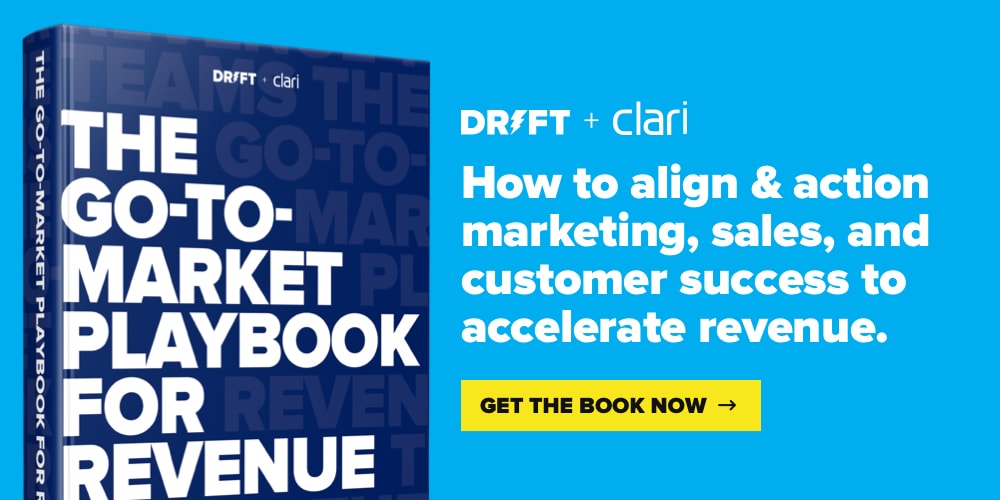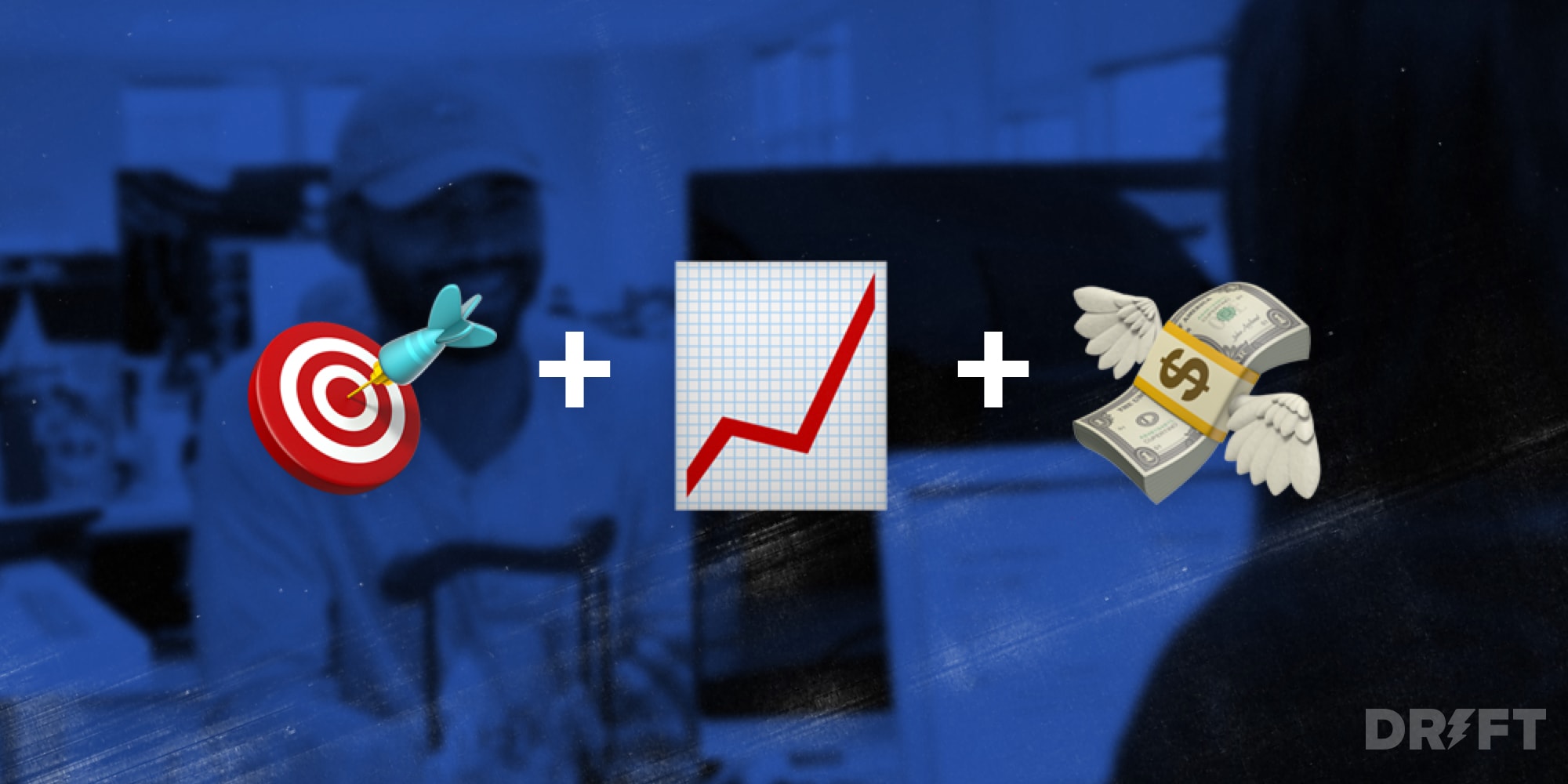Hey everyone, it’s Mark, Drift’s VP of Content & Community. If you’ve read any of my blog posts in the last 18 months or so, then you already know I’m a huge fan and advocate for Conversational Marketing. Maybe even the biggest. But that’s another post 😏
We’re happy to lead the conversation around Conversational Marketing, but we keep noticing a big problem. Conversational Marketing has been equated with chatbots and live chat, but it’s so much more than that.
The real goal of Conversational Marketing isn’t to add chat to your website. The real goal is to accelerate revenue.
Isn’t that what all businesses want? Would anyone want to slow down revenue? Would anyone want to make potential customers wait longer to seal the deal? Of course not.
While Conversational Marketing is designed to accelerate revenue, it can’t do it alone. It needs Conversational Sales.
So that’s why I’m going to lay it all out there for you. I’m going to detail the difference between Conversational Marketing and Conversational Sales, how they both work to accelerate revenue, the types of friction to avoid, and the steps you need to follow in order to accelerate revenue at your organization.
The Difference Between Conversational Marketing and Conversational Sales
Both Conversational Marketing and Conversational Sales use communication channels that customers actually want to use. Both are aimed at reducing friction. Both make the buying experience faster and more enjoyable.
But there are differences. Let me break them down for you.
- Conversational Marketing – Conversational Marketing allows you to see exactly where visitors came from and how they have interacted with you in the past so you can align your channel, offer, and messaging accordingly. From the moment a visitor lands on your site, everything is about them: their background, motivation, challenges, and needs. Suddenly, your visitors aren’t receiving the same generic experience. You can target specific groups of potential buyers to deliver the personalized experience they’re looking for. For example, your paid traffic gets one experience, while existing customers enjoy a totally different one. And your high-value target accounts get the red carpet experience.
- Conversational Sales – Conversational Sales gives your sales team a healthy pipeline of qualified meetings and the real-time visibility, insights, and communication tools they need to prioritize target accounts, be more productive, and win more business, faster.
Your sales team can immediately recognize prospects from existing customers, personalize their engagement, and tailor their pitch to create value – all while delivering the exact experience your customers deserve.
It all comes down to giving the potential customer what they need at that moment (and satisfying their needs as quickly as possible). Maybe what they need is to sign up for your product, or maybe they simply need to get started with reading and implementing the advice in one of your best ebooks.
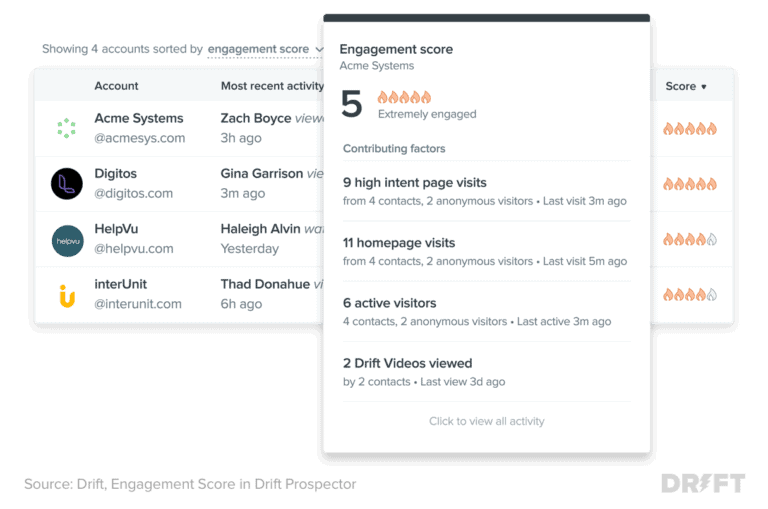
When you’ve got great marketing in place, it’s much easier for salespeople to identify the top priority leads, based on the lead’s activity.
Check Out My Podcast Interview on Conversational Marketing and Conversational Selling
I talk about combining Conversational Marketing and Conversational Sales to accelerate revenue on the Selling in Asia podcast, hosted by Tom Abbott.
Why Being Conversational Accelerates Revenue
The goal of both Conversational Marketing and Conversational Sales is to accelerate revenue by meeting your customer where they are and delivering a top-notch customer experience.
This looks like reducing friction and talking to customers via communication platforms they actually use. When was the last time you used a website form to invite your mother over for dinner? Probably never (I hope).
Helping your potential customers in the most natural, human way possible accelerates revenue. It really is that simple.
To put this into practice at your organization, you need to start off with two key things: reduce friction by using channels we use every day in our lives.
The Types of Friction You Need to Alleviate to Accelerate Revenue
When people want your help (and want to give you money), you should make it easy for them. Ready to reduce the friction getting in their way? Here are some examples of the types of friction that slow down revenue and frustrate your potential customers.
Website forms. Most web forms ask for information that the sales team needs to qualify the lead. They’re designed to get what the business needs, but aren’t really designed for the customer. On the flip side, Conversational Marketing seeks to help the potential customer first, and gather information about them along the way.
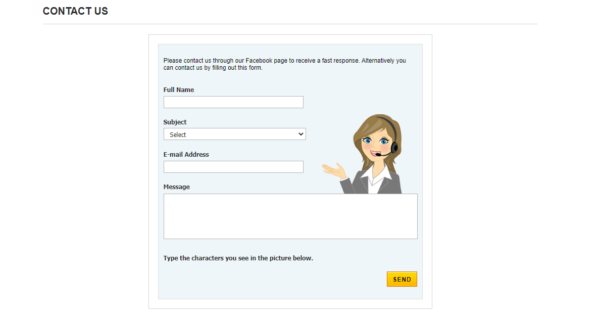
(Talk about friction – this captcha is majorly faulty.)
Confusing website. Ever been pitched the wrong thing? This happens often. Customers can be served content or offers that are too beginner, too advanced, or otherwise don’t match their needs. Conversational Marketing and Sales relies on integrated customer data and a human touch to make the right offers.
Lack of personalization. While getting sent the wrong offers is related to a lack of personalization, there can be other issues at play. Maybe the offer is right, but sent to the wrong person. You’re communicating with the user and talking to them like they’re the buyer, or vice versa. Drift’s Revenue Acceleration Platform helps you add more of the right contacts to each target account and communicate with them based on whether they’re a potential user, champion, buyer, or something else.
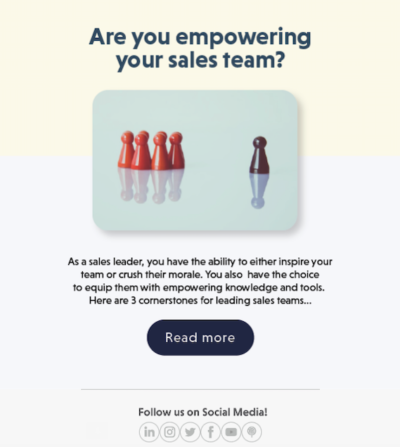
(The audience of this email isn’t just salespeople, but the email is only relevant to sales leaders.)
Chat prompts that are too fast or too slow. This is a micro-example of friction, but it’s important. Setting up chat prompts on your site doesn’t mean you’re doing Conversational Marketing well. You might have a user reading a landing page for one minute, and they’re still confused, but they don’t get a chat prompt asking if they have any questions about the page. On the other hand, you can have too many chat prompts that are asking too many things at once, overwhelming your user. Both issues cause high bounce rates.
Lack of desired content type. Maybe you love to watch videos. Maybe you’d rather read. Your potential customers have their own content consumption preferences as well. Not making it easy to choose different formats of content at every step of the journey is a huge example of friction.
Wrong communication channels available. Think of the channel you use when contacting customer support for your favorite online store. Do you send an email, start a live chat session, or call the hotline? Your potential customers also have their own favorite communication channels. Maybe that chosen channel differs when they’re busy versus when they’ve got a lighter workload. It’s essential to have multiple ways for potential customers to communicate with you and move down the path to a closed sale.
How to Be More Conversational (Chat Is Only the Beginning)
Remember how I mentioned that chat is not synonymous with Conversational Marketing? Chat is a tool and a communication channel, while Conversational Marketing is the entire process of making it faster and easier for people to become leads.
Here are all of the communication channels that we recommend and use in our Revenue Acceleration Model:
- Chat – Chatbots and live chat
- Email – Automated for downloadable asset delivery, email nurturing and newsletters, one on one emails
- Video – Personalized for sales enablement, and marketing content at scale
- Voice – Personalized communication for selling and customer success
- SMS – Personalized communication for sales enablement, confirming appointments, following up
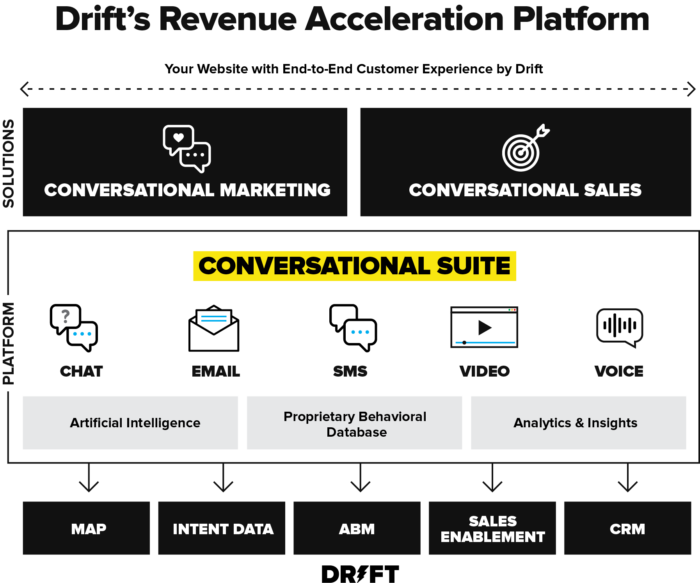
Our Revenue Acceleration platform combines all five customer-centric communication channels.
The 5 Stages to Follow to Accelerate Revenue
Want to take things deeper and peek at what next-level revenue acceleration looks like?
The Revenue Acceleration Model consists of 5 stages that help your organization practice Conversational Sales and Marketing so you can make it faster and easier to gain revenue and to satisfy your customers.
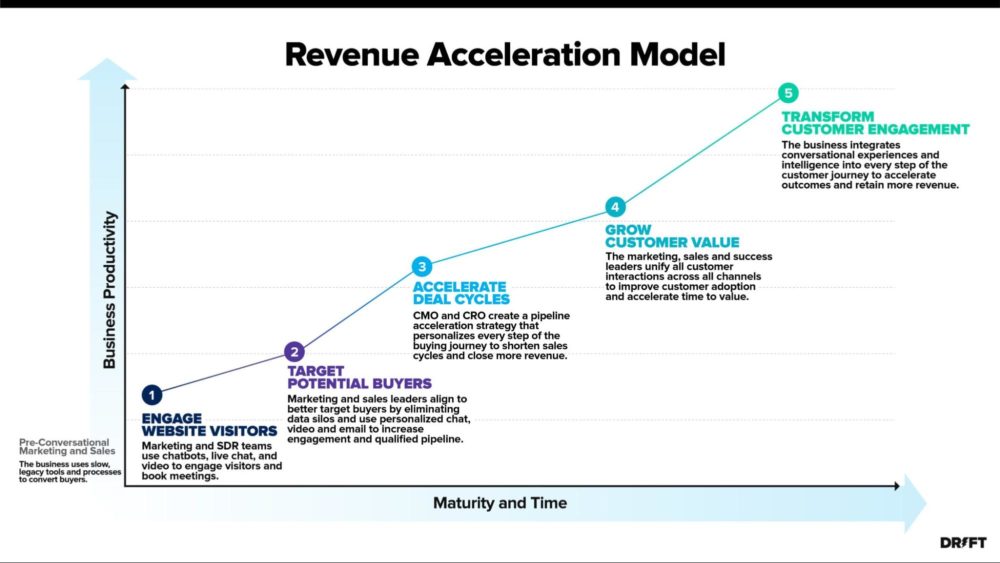
1. Engage website visitors
During this stage, marketing and SDR teams create conversational experiences using chatbots, live chat, and video to engage more visitors and book meetings. Your team focuses on reducing friction with the website and helping marketers cater to customers’ immediate needs.
- Goal – Book meetings.
- Actions – Fix the friction on your website and every channel involved in converting traffic into leads. Find ways to make it easier for people to become leads and book meetings, from better resources to more natural communication channels.
2. Target potential buyers
In Stage 2, marketing and sales leaders work together to find and engage with the right buyers. The focus is on eliminating data silos and using personalized chat, video, and email, to build qualified pipeline.
- Goal – Build pipeline.
- Actions – Use data to discover the right contacts at target companies. Prioritize targets based on their likelihood to convert and signs of fit and interest.
3. Accelerate deal cycles
Now it’s time for your CMO and CRO to work together to create a pipeline acceleration strategy that personalizes outbound and ABM strategies in order to increase conversion rates and improve sales productivity.
- Goal – Close revenue
- Actions – Help sales talk to the right prospects at the right time using the right channel
4. Grow customer value
Marketing, sales, and customer success create an integrated source of data for customer interactions across all channels to help close more deals and accelerate time to value (and revenue).
- Goal – Increase lifetime value by way of customer product adoption
- Actions – Improve customer success and onboarding by putting Conversational Marketing and Sales techniques and channels in the hands of your customer success team.
5. Transform customer engagement
During this final stage, the business is now focused on integrating conversational experiences into every step of the customer journey. This helps customers feel heard, supported, and taken care of as quickly as possible, so they wouldn’t dream of leaving you for a competitor.
- Goal – Maximize lifetime value by way of customer retention
- Actions – Engage customers across every stage of the customer journey. Identify issues in pipeline-building activities, sales cycles, onboarding, and renewal.
Faster revenue is better for everyone involved. And taking better care of leads and customers is the only real, lasting way to accelerate revenue 📈




